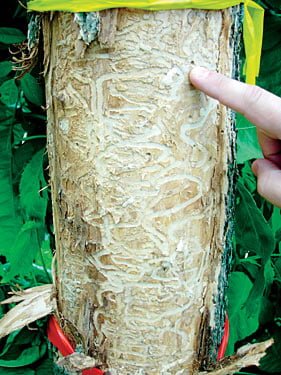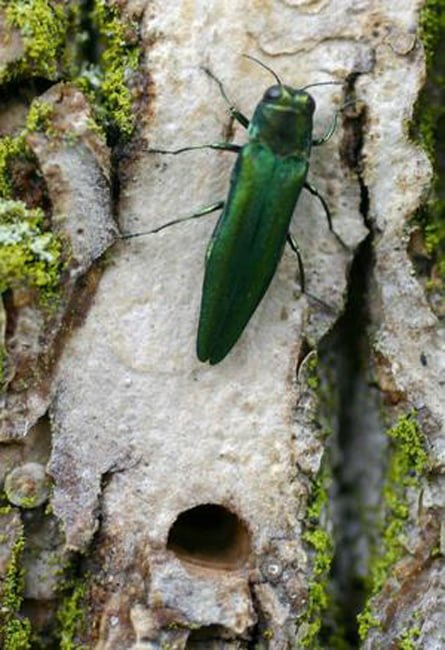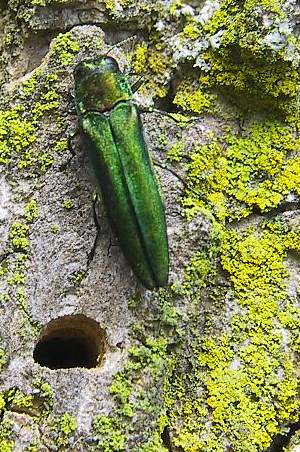Does My Tree Have the Emerald Ash Borer?
Emerald Ash Borer damage spotted in Wappingers falls. If the Ash trees are valuable to your landscape, they can be treated. If not, they make good firewood.

The emerald ash borer (Agrilus planipennis Fairmaire) is a shiny emerald green beetle that kills living ash trees. Ash (genus Fraxinus) is found throughout many of the forests in eastern North America and it is a commonly planted street and landscape tree.
Signs and symptoms are indicators of insect attack. A sign is physical damage to a tree, such as a gallery, a hole, or a feeding notch in the leaf, resulting from attack by an insect. A symptom is a tree’s response to insect attack and includes premature yellowing of foliage, dead branches, thinning crowns, or bark cracks. Similar signs and symptoms can be caused by other pests, drought, or cold stress and therefore you need an expert to verify that emerald ash borer is present in the tree.
Symptoms
Crown dieback: Trees start to show dead branches throughout the canopy, beginning at the top. Larval feeding disrupts nutrient and water flow to the upper canopy, resulting in leaf loss. Leaves at the top of the tree may be thin and discolored.
Epicormic Sprouting: When trees are stressed or sick, they will try to grow new branches and leaves wherever they still can. Trees may have new growth at the base of the tree and on the trunk, often just below where the larvae are feeding.
Bark splits: Vertical splits in the bark are caused due to callus tissue that develops around larval galleries. Larval galleries can often be seen beneath bark splits.
Woodpecker feeding: Woodpeckers eat emerald ash borer larvae that are under the bark. This usually happens higher in the tree where the emerald ash borer prefers to attack first. If there are large numbers of larvae under the bark the woodpecker damage can make it look like strips of bark have been pulled off of the tree. This is called “flecking.”
Signs

D-shaped emergence holes: As adults emerge from under the bark they create a D-shaped emergence hole that is about 1/8 inch in diameter. An example of this is shown below.
S-shaped larval galleries: As larvae feed under the bark they wind back and forth, creating galleries that are packed with frass (larva poop) and sawdust and follow a serpentine pattern. An example of this is shown below.
Larvae: Larvae are cream-colored, slightly flattened (dorso-ventrally) and have pincher-like appendages (urogomphi) at the end of their abdomen. By the time larvae are done growing they are 1 1/2 inches long. Larvae are found feeding beneath the bark.
Adults: Adult beetles are metallic green and about the size of one grain of cooked rice (3/8 – 1/2 inch long and 1/16 inch wide). Adults are flat on the back and rounded on their underside.


